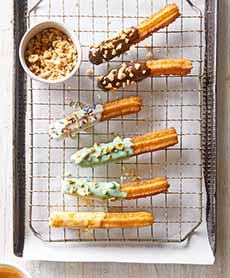Baked Churros Recipe & The History Of Churros
|
You don’t have to wait until Cinco de Mayo to make a batch of churros.
But this lesser-guilt recipe for baked churros (instead of fried), from The Baker Chick, is reason enough to serve them anytime. The recipe is below, but first: According to Fox News Latino and other sources, churros evolved from a Chinese cruller* (youtiao). Portuguese sailors discovered them them on their Far East voyages, which reached China in the early 16th century. They brought the recipe home with them; but that pastry was savory, seasoned with salt. The recipe spread to Spain, and the Spanish improved on the concept by adding sweetness. And, prior to frying, they passed the dough (extruded) through an implement with a star-shaped tip that created ridges. That implement is a churrera, a syringe-like utensil that features that dies of different shapes. It is still used today. The original was a star shape; but the churrera, (an inexpensive tool) comes with different die attachments, so today pastry makers have a choice. In addition to the eye appeal, the signature ridges created by the tip turned out to be great for holding dipping sauces: an improvement over the original. The churros were dusted in cinnamon and sugar, and dipped in chocolate sauce, and enjoyed at breakfast with café con leche or hot chocolate (hot chocolate developed in Spain around the same time as churro pastries). Churros arrived in Europe in the 16th century, at the same [relative] time cacao came from Mexico to Europe, and became hot chocolate. While traveling from country to country, the churro was enhanced, from guava-filled churros in Cuba, the dulce de leche-filled churros in Mexico and cheese-filled churros in Uruguay. Dulce de leche, a popular sauce for churros, was invented in Argentina in the 19th century. The first historical reference to the Argentinian dessert comes from a peace meeting between military leaders in 1829. According to legend, dulce de leche was produced by accident when the maid was cooking some milk and sugar and was unexpectedly called away. Upon her return, the mixture had transformed into a thick, brown consistency (not very different from caramel sauce, which is made with sugar, cream and butter). The “new dessert” was called dulce de leche, a milk sweet [confection]. Today it is usually made with sweetened condensed milk (which did not exist at the time). |
|
|
|
________________
*The Chinese cruller, youtiao, also popular in, Malaysia, Singapore and Vietnam. †There is also a story about nomadic Spanish shepherds developing churros while tending their flocks in the mountains. There are breeds of Spanish sheep called the navajo-churro and the churra, the horns of which are said to look similar to the fried pastry. This story is highly unlikely. At the time, sugar was very expensive, and not likely to be available to the shepherds. Not to mention, “churro” comes from “churrera.” |
||
 [4] While these churros are baked, in Mexico, where they are fried, they are often served in paper to absorb some of the oil (photos #4 and #5 © The Baker Chick).
|
RECIPE: BAKED CHURROS
Ingredients For 18-20 Churros ________________ ‡If you don’t have large eggs, use what you have but aim for 2/3 cup of egg. A larger amount could yield more watery dough. Preparation 1. PREHEAT the oven to 350°F. In a medium saucepan combine the butter, salt and water. Bring to a boil over medium high heat. 2. REMOVE from the heat add the flour; stir to combine. The mixture will thicken and start to resemble the texture of mashed potatoes. 3. LEAVE the dough in the saucepan, but beat it on low with a hand mixer, adding one egg at a time and mixing well before adding another. After adding each egg, the mixture will become wet and glossy, but after mixing on high for a few seconds it will thicken again. When all the eggs are are combined… 4. ADD the vanilla. The dough will be thick and starchy, still with a similar texture to mashed potatoes. Spoon the dough into a pastry bag fitted with a large star tip. Lightly spray a cookie sheet and pipe 6-inch rows of the dough with at least 1 inch between each churro. 5. BAKE in the oven for 20-25 minutes or until golden brown and crispy. 6. REMOVE from the oven, brush the warm churros with melted butter or spray lightly, and place in a shallow baking dish. Sprinkle with cinnamon sugar and shake the dish to make sure they are well-coated. Churros are best enjoyed warm. If they cool to room temperature, give them 30 seconds in the microwave. |
|
|
|
||






